-

北师大初中数学九年级上册菱形的性质2教案
1. _____________________________________________2. _____________________________________________你会计算菱形的周长吗?三、例题精讲例1.课本3页例1例2.已知:在菱形ABCD中,对角线AC、BD相交于点O,E、F、G、H分别是菱形ABCD各边的中点,求证:OE=OF=OG=OH.四、课堂检测:1.已知四边形ABCD是菱形,O是两条对角线的交点,AC=8cm,DB=6cm,菱形的边长是________cm.2.菱形ABCD的周长为40cm,两条对角线AC:BD=4:3,那么对角线AC=______cm,BD=______cm.3.若菱形的边长等于一条对角线的长,则它的一组邻角的度数分别为 4.已知菱形的面积为30平方厘米,如果一条对角线长为12厘米,则别一条对角线长为________厘米.5.菱形的两条对角线把菱形分成全等的直角三角形的个数是( ).(A)1个 (B)2个 (C)3个 (D)4个6.在菱形ABCD中,CE⊥AB,E为垂足,BC=2,BE=1,求菱形的周长和面积
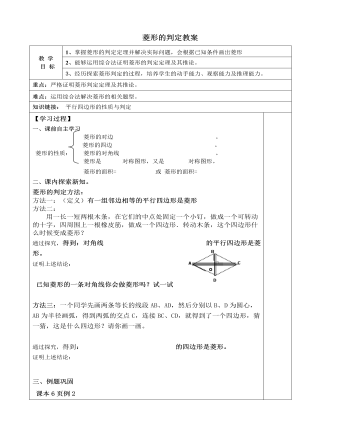
北师大初中数学九年级上册菱形的判定2教案
方法三:一个同学先画两条等长的线段AB、AD,然后分别以B、D为圆心,AB为半径画弧,得到两弧的交点C,连接BC、CD,就得到了一个四边形,猜一猜,这是什么四边形?请你画一画。通过探究,得到: 的四边形是菱形。证明上述结论:三、例题巩固课本6页例2 四、课堂检测1、下列判别错误的是( )A.对角线互相垂直,平分的四边形是菱形. B、对角线互相垂直的平行四边形是菱形C.有一条对角线平分一组对角的四边形是菱形. D.邻边相等的平行四边形是菱形.2、下列条件中,可以判定一个四边形是菱形的是( )A.两条对角线相等 B.两条对角线互相垂直C.两条对角线相等且垂直 D.两条对角线互相垂直平分3、要判断一个四边形是菱形,可以首先判断它是一个平行四边形,然后再判定这个四边形的一组__________或两条对角线__________.4、已知:如图 ABCD的对角线AC的垂直平分线与边AD、BC分别交于E、F求证:四边形AFCE是菱形

北师大初中数学九年级上册菱形的判定1教案
(1)求证:四边形BCFE是菱形;(2)若CE=4,∠BCF=120°,求菱形BCFE的面积.(1)证明:∵D、E分别是AB、AC的中点,∴DE∥BC且2DE=BC.又∵BE=2DE,EF=BE,∴EF=BC,EF∥BC,∴四边形BCFE是平行四边形.又∵EF=BE,∴四边形BCFE是菱形;(2)解:∵∠BCF=120°,∴∠EBC=60°,∴△EBC是等边三角形,∴菱形的边长为4,高为23,∴菱形的面积为4×23=83.方法总结:判定一个四边形是菱形时,要结合条件灵活选择方法.如果可以证明四条边相等,可直接证出菱形;如果只能证出一组邻边相等或对角线互相垂直,可以尝试证出这个四边形是平行四边形,然后用定义法或判定定理1来证明菱形.三、板书设计菱形的判 定有一组邻边相等的平行四边形是菱形(定义)四边相等的四边形是菱形对角线互相垂直的平行四边形是菱形对角线互相垂直平分的四边形是菱形 经历菱形的证明、猜想的过程,进一步提高学生的推理论证能力,体会证明过程中所运用的归纳概括以及转化等数学方法.在菱形的判定方法的探索与综合应用中,培养学生的观察能力、动手能力及逻辑思维能力.
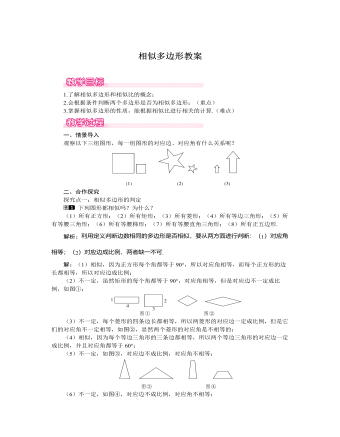
北师大初中数学九年级上册相似多边形1教案
(2)如果对应着的两条小路的宽均相等,如图②,试问小路的宽x与y的比值是多少时,能使小路四周所围成的矩形A′B′C′D′和矩形ABCD相似?解析:(1)根据两矩形的对应边是否成比例来判断两矩形是否相似;(2)根据矩形相似的条件列出等量关系式,从而求出x与y的比值.解:(1)矩形A′B′C′D′和矩形ABCD不相似.理由如下:假设两个矩形相似,不妨设小路宽为xm,则30+2x30=20+2x20,解得x=0.∵由题意可知,小路宽不可能为0,∴矩形A′B′C′D′和矩形ABCD不相似;(2)当x与y的比值为3:2时,小路四周所围成的矩形A′B′C′D′和矩形ABCD相似.理由如下:若矩形A′B′C′D′和矩形ABCD相似,则30+2x30=20+2y20,所以xy=32.∴当x与y的比值为3:2时,小路四周所围成的矩形A′B′C′D′和矩形ABCD相似.方法总结:因为矩形的四个角均是直角,所以在有关矩形相似的问题中,只需看对应边是否成比例,若成比例,则相似,否则不相似.
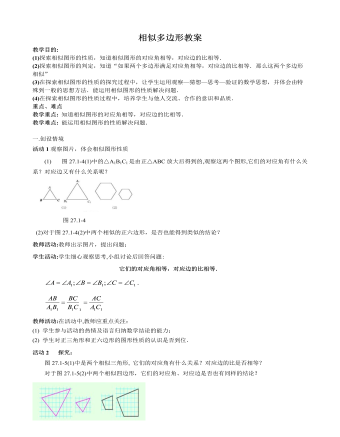
北师大初中数学九年级上册相似多边形2教案
(2)相似多边形的对应边的比称为相似比;(3)当相似比为1时,两个多边形全等.二、运用相似多边形的性质.活动3 例:如图27.1-6,四边形ABCD和EFGH相似,求角 的大小和EH的长度 .27.1-6教师活动:教师出示例题,提出问题;学生活动:学生通过例题运用相似多边形的性质,正确解答出角 的大小和EH的长度 .(2人板演)活动41.在比例尺为1﹕10 000 000的地图上,量得甲、乙两地的距离是30 cm,求两地的实际距离.2.如图所示的两个直角三角形相似吗?为什么?3.如图所示的两个五边形相似,求未知边 、 、 、 的长度.教师活动:在活动中,教师应重点关注:(1)学生参与活动的热情及语言归纳数学结论的能力;(2)学生对于相似多边形的性质的掌握情况.三、回顾与反思.(1)谈谈本节课你有哪些收获.(2)布置课外作业:教材P88页习题4.4

小学语文四年级上册第3课《鸟的天堂》优秀教案范例
首先我们进入到真正的鸟的天堂,也就是你们的天堂去看一下: 1.出示课件(12-13自然段的内容) 2.自由读这一部分,这一部分写出了“鸟的天堂”什么特点?(活泼可爱、鸟多)你是从哪些地方感悟到的?(自由发言) 3.当学生读到“应接不暇”一词时,问:这个词是什么意思呢?出示课件“群鸟纷飞”图帮助理解。 4.这一段主要应读出它的什么特点来呢?(热闹)对,这就是它的动态美,这一段主要写出了鸟的天堂的动态,让我们一起来读出它的动态美。(引导读“有的…有的…有的…”和“一只画眉鸟…那歌声真好听…”读出鸟的可爱;引导读“到处都是鸟声,到处都是鸟影”和“眼睛应接不暇…”读出鸟的多。) 5. 学生读完后问:这一只小鸟在兴奋地叫着,它可能在说什么呢?(可能在说,我在这里真快活。)假如你就是这只小鸟,你为什么会喜欢这个地方呢?让我们将自己的视角往小鸟生活的环境──大榕树身上聚集。
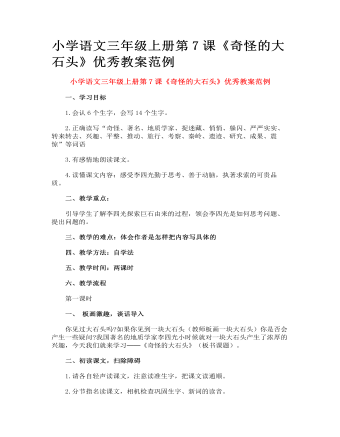
小学语文三年级上册第7课《奇怪的大石头》优秀教案范例
质疑解难 1.结合资料袋中的内容介绍本文主人公一李四光。 2.学生针对课文内容质疑,师生共同解疑。 (1)对预习认真,能主动、正确解疑的同学给予表扬。 (2)主要解决以下疑难: 陨石:大的流星在经过地球大气层时,没有完全烧毁坠落到地球上的含石质较多或全部为石质的陨星。 地质学家:从事地球物质形成和地壳构造研究,以探讨地球的形成和发展的科学家。 突兀:高耸。 第四纪:地质历史的最后一个纪。约250万年前至今。此时高纬度地区广泛地发生了多次冰川作用。 冰川:在高山或两极地区,积雪由于自身的压力变成冰块(或积雪融化、下渗冻结成冰块儿又因重力作用而沿着地面倾斜方面移动,这种移动的大冰块叫做冰川。在地质上的新生代第四纪,气候非常寒冷,世界上的许多地方被冰川覆盖,称第四纪冰川。 秦岭:横贯我国中部,东西走向的古老语皱断层山脉。我国地理上的南北分界线。分布有冰川槽谷、角峰等。
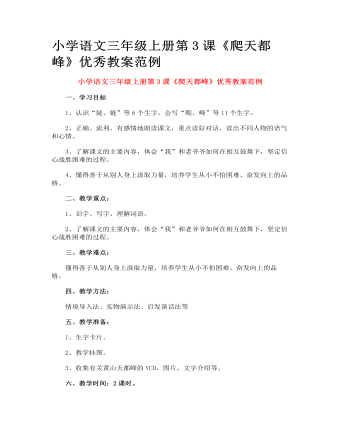
小学语文三年级上册第3课《爬天都峰》优秀教案范例
深入读议,体会“我”受鼓舞爬上峰顶 1、在爬山之前,望着又高又陡的天都峰,“我”心里是怎么想的?默读课文,圈点勾画,想想从哪些词语、句子中看出“我”有害怕畏惧的心理。 指名交流,出示并指导读好问句“我爬得上去吗?”、感叹句“真叫人发颤!”以及语气词“啊”“哩”等,读中体会“我”缺乏自信、畏惧退缩的心理。 2、结果“我”爬上峰顶了吗?自由读课文的第8至10自然段,出示“我”说的话,指名朗读。 3、“我”看到了什么从而下定决心爬上峰顶呢?自由读课文第3到7自然段,想想我的心理发生了怎样的变化。 a. 出示第4段重点句,引导学生深入讨论交流,从中感受到“我”受老爷爷爬山鼓励而下定决心爬上峰顶的内心活动。 b. 体会“我”的心理,指导朗读3、4自然段。 4、“我”是怎么爬的?自由读6、7自然段,画出描写爬山动作的词语。 a. 学生读书圈划。 b.学生交流。引导学生联系上下文,体会“奋力”是拼尽全身力气的意思。 从“攀着铁链”、“手脚并用向上爬”可以看出爬山的艰难。 c.引读第7段,从“终于”二字上体会爬得辛苦、上山后的喜悦。 d. 体会爬山的艰难、上山后的喜悦,指导朗读6、7两段。
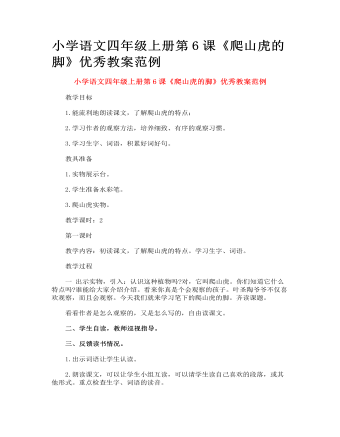
小学语文四年级上册第6课《爬山虎的脚》优秀教案范例
请同学们看实物。 1.你看到了什么? 2.有什么特点? 3.你能用一两句话把这些特点连起来说说吗? 4.叶圣陶爷爷笔下的爬山虎的叶子怎样呢?自由朗读第二自然段。 5.读了有什么感受?(美)哪些地方写的美?你喜欢哪句? 6.自己感受一下风吹时爬山虎叶子的美。做一做拂过、漾起的动作,你能读好这句话吗?想欣赏一下风吹爬山虎的样子吗? 7.老师指导读出美来。可以采取老师读前半句,学生补充后半句的读法,也可以男女生分组读,让学生充分感受爬山虎叶子的美。 8.作者为什么把叶子写的这么美呢?(认真观察)所以我们要学习作者认真仔细地观察事物的方法,养成良好的观察习惯。 爬山虎的叶子之所以生机勃勃地铺满墙,这跟它的脚有密切的联系,爬山虎的脚又是什么样的呢?
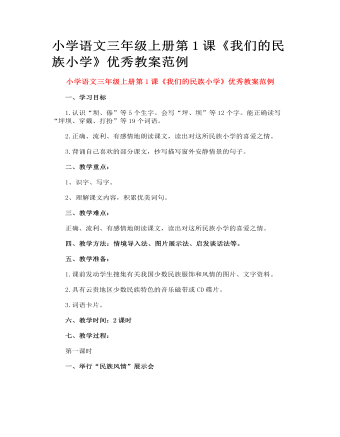
小学语文三年级上册第1课《我们的民族小学》优秀教案范例
举行“民族风情”展示会 我国是一个多民族的大家庭。五十六个民族,五十六朵花。不同的的民族有不同的服饰,更有不同的风俗。下面我们举行一个“少数民族风情”展示会,请你展示自己找到的有关图片,介绍自己了解的少数民族的情况。 学生展示介绍,教师提示学生着重介绍少数民族的服饰特征、生活习俗。 二.视学生介绍情况,教师利用课后资料袋中的图片,补充介绍课文中涉及的傣族、景颇族、阿昌族、德昂族等少数民族的情况。 三.评选最佳学生,颁发小奖品。 揭示课题,范读课文。 1.在我国西南边疆地区,有好多民族聚居在一起,共同生活,和睦相处。不同民族的孩子们也在一所学校共同学习。就有这样的一所民族小学,大家愿意不愿意去参观一下? 2.板书课题:我们的民族小学。 3.教师配乐范读。选择具有云贵民族风情的乐曲,如《小河淌水》、《蝴蝶泉边》、《有一个美丽的地方》等配乐。
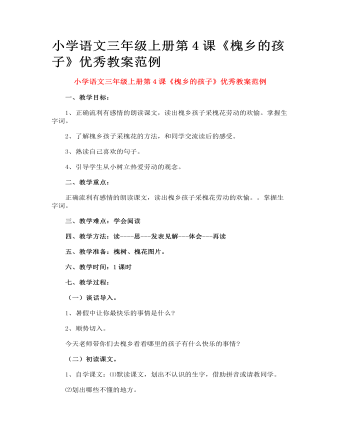
小学语文三年级上册第4课《槐乡的孩子》优秀教案范例
课堂上把重点放在了让学生在读的过程中体会出槐乡孩子的懂事、吃苦耐劳和以苦为乐的特点,因为是略读课文,所以我就只提了一个问题,槐乡的孩子与我们有什么不同呢?让学生通过各种方式的读说自己读了课文后的的体会。学生在回答时,大都抓住了“勤劳的槐乡孩子是不向爸爸妈妈伸手要钱的,他们上学的钱是用槐米换来的.”及槐乡孩子的勤劳,对此学生感受最深,槐乡孩子以苦为乐的精神,是靠我点出来了,当时有部分学生说第三段写的槐乡孩子干活时的样子写得很好,当时天很热他们还在干活.我就趁机引导学生朗读体会当时天气的热,又读一读描写干活时的句子,学生体会到孩子们劳动时是很快乐的。学生已经能够通过读文理解文中的内涵,但总结的能力不行,大都是只看到点,看不到面。反思本节课,虽然课文都是由学生具体读,但都是我直接参与指导方法等,是我一步步引着走的,属于半放半扶。下次的略读课我打算完全放手,由各学习小组的组长和学生一起学习。

小学语文三年级上册第6课《小摄影师》优秀教案范例
介绍人物,导入新课 1、启发谈话。课前同学们自己已经读过了课文,查阅了有关资料,谁能向大家介绍一下高尔基? 2、学生之间交流收集的有关高尔基的资料。 3、师出示高尔基的画像,并归纳:高尔基(1886年~1936年),是苏联伟大的无产阶级文学家,世界著名的文学家。他写了很多书,发表了《童年》、《在人间》、《我的大学》、《母亲》等多部小说以及著名的散文诗《海燕》和一系列剧本。“书籍是人类进步的阶梯”这句脍炙人口的名言,就出自高尔基的笔下,全世界人民都很敬爱他。他的作品在我国广为流传,得到人们的喜爱。今天,我们来学习高尔基与一位小学生之间的故事:小摄影师。(板书,提示“摄”的读音。) 高尔基与小摄影师之间到底发生了什么事呢?我们下面来看课文

人教版新目标初中英语七年级下册How was your weekend教案2篇
Teaching Goal:1. General aims:Talk about recent past events2. Particular aims:A. Language Focus.Talk about recent past events and think of the past events.B. Language goalsHow was….?It was …What did …do over the weekend?C. Language structures:(1). How was your weekend? I was great. Pay attention to no form.(2). What did you do over the weekend? I played soccer. We went to the beach.D. Useful words and phrases:Words: was, did, went, beach, over, project, test, wasn’t, false, number, geography, spend, week, most, mixture, their, had, little, cook, read, saw, change, everyone, sit, sat, no, anythingPhrases: did one’s homework, played soccer, cleaned my room, went to the beach, played tennis, went to the movies, on Saturday morning, over the weekend, cook … for, what about, do some reading, have a party, talk show, go shoppingE. Grammar language:Present simple past tenseRegular and irregular verbsF. Learning strategies:Tour and holidaysG. Interdiscipinary:H. Emotion and manner:Teaching time: 5 periodsTeaching procedures:Period One教学步骤、时间 教师活动 学生活动 媒体应用Step 1Free talk 3’ Ask some questions like:Who’s on duty today?What’s the weather like? Answer and talk about something.让同学们回答下列问题1. Do you like weekend? (Let some students answer)It takes them three minutes to talk about the question.2. Why do you like weekend? (let the students answer) Most of the students like the weekend此时教师用汉语问:“在周末期间问你干了什么?这句话用英语这么回答?Let the students guess.At last the teacher give them right answer3. What did you do over the weekend?(板书、学习)

人教版新目标初中英语七年级下册What does he look like教案3篇
所需要用到的句子:Who is that?That is Jack. I like him.Why do you like him?I like him because he is interesting.Task 4: 设计理想中的人类Step one: 设计理想中的人类的外貌。把全班同学分成若干小组,学生可以边说边在纸上画出他们的模样。Step two: 设计理想中人类的性格。学生们可以把那些能描述性格的单词写在图画的旁边。Step three: 每组选出一名同学,其他同组同学提问,他作简单回答,并说明原因。所需用到的句子:What does he or she look like?He or she ...What is he or she like?He or she is ...Why?Because ...Task 5: 挑战性活动调查性格是天生的还是后天形成的,让每个同学回家去调查一下自己成长过程中性格是否有变化,具体是怎样的,为什么会这样? Teaching Aims:1. Enable students to have a general understanding of how to talk about people's physical appearance.2. Enable students to tackle some essential vocabularies and patterns about describing people. Provide them with necessary skills and methods.3. Create various chances for students to describe the persons they're familiar with, such as classmates, family members, teachers, idols, etc.

人教版新目标初中英语七年级下册Where is the post office教案2篇
Period 2 (3a----Section B 2c)Preview(Pre-task): Key points: What laAdd another information about their pen pals----their language on the cardnguage does she/he speak?She/He speaks....Does she/he have any brothers and sisters? Does she/he speak English?Preview(Pre-task): Add another information about their pen pals----their language on the cardKey points: What language does she/he speak?She/He speaks....Does she/he have any brothers and sisters? Does she/he speak English?Step 1 Revision1.Revisionand dictation of the new words 2.Revise the drills they learned yesterday.(by pairwork and grammar exercise)Step 2 Leading-inT has a conversation with one student. The conversation is following:---Do you have a pen pal?---Yes, I do.---What's your pen pal's name? ---His/Her name is....---Where is your pen pal from? ---He/She is from...---Where does he/she live? ---He/She lives in....---What language does he/she speak?He/She speaks...Write the new words on the Bb. They are following: EnglishChineseJapaneseFrenchStep 3 LearnLearn the new words with the whole class.Finish 3a with the students3b Pairwork T still does an example with one student Then the Ss practise in pairs. The example is following:--Curry Muray is my pen pal. He is from the United States.---What language does he speak?

人教版新目标初中英语七年级下册Don’t eat in class教案2篇
Don’t fight. =You can’t fight. (板书,教读)教师把这些句子板书在黑板上,并请学生大声整齐地读祈使句和“can’t”句型,并让学生注意两种句型表达形式的不同和转换,“Don’t …=You can’t…”;并对学生说:These are our school rules. (板书,教读) You can’t break the school rules. Don’t break the school rules.(板书,教读)步骤3 :Practicea. T: Now, each of the students is breaking one of these rules.Please finish 1a.学生看图,完成1a的内容,检查答案并大声朗读校规。b. 听录音,完成1b,选出四位学生都违反了哪条校规;听之前,学生要读会英文名。c. 请两位学生朗读1c部分的句型;要求学生两人一组对话表演,SA扮演外校转来新生,SB告知本校校规。(学生可经过讨论,多说出他们想到的校规,不必只限于书上;教师应给予帮助)2) 第二课时(2a~4)步骤1 :warming up of revisionT: What are the rules at your school?学生使用“can”或祈使句表达各条校规;其中老师可引出“eat in the cafeteria outside”的表达。步骤2 :Practicea.T: Christina is an exchange student. She doesn’t know the rules. Let’s listen, what activities they’re talking about?学生听第一遍时,完成2a;第二遍时,完成2b;b. 请学生领读2c部分,看着2a完成的表格,理解2c活动的要求;分成小组针对2a进行问答;

人教版新目标初中英语七年级下册I ’d like some noodles教案
教学过程Step 1: warming-up Sing a song---------“food and drink” Step 2: Revision1 Dictation2 Revise: What kind of noodles would you like?I’d like …What size bowl of noodles would you like?I’d like…Step 3: Presentation1 show pictures of food, ask students say the words.2 Students read the newspaper ad in 3a. Fill in blanks with words in the box. Then read the ad together, the teacher explains some difficult language points.3 Check the answers Step 4 PracticeAsk students to finish 3b in the same way according to 3a. Students read the short passage and fill in the blanks .At last, check the answers.Step 5 productionAsk students to write their own ad for dumplings, noodles, drinks, and other foods they know. Then ask students to read their partner’s ad. Then order food and drink from their partner.Step 6 Home workGroup work – make an ad about “food and drink”

人教版新目标初中英语七年级下册I want to be an actor教案2篇
三、教学建议第一课时:1. Lead in (Vocabulary)A) Before class, teacher should collect some pictures of working places. For example: Bank, TV Station, Restaurant, Police Station, Hospital ...B) In class, show students the pictures (PowerPoint, OHP). Ask students to tell the name of the working places and the name of the jobs.Shop assistant, doctor, actor, reporter, police office, waiter, bank clerk, studentC) Do exercise 1a and 3a.2. Bingo GameAsk groups of students to make up pairs of cards with a job on one and the related workplace on the other. For example, waiter / restaurant, teacher / school, doctor / hospital. Encourage students to use both the job / workplace combinations in the book and the ones that students came up during class discussions. Be sure they have twice as many sets of cards as there are students in the group. They can make two sets of cards for a single job / workplace, if necessary. Then have each group mix up its set of cards and hand their cards out in random order. Each time a student gets a pair of cards that match, he or she can lay these cards down. The goal is to have no cards in your hand at the end.3. Task OneA) Ask students to work in pairs and ask the partner what does he / she want to be in the future.e. g. :What do you / does he / does she want to be?I want to be a.Why?Because it's (adj).B) Vocabulary: Section B, 1a4. Homework 1.2.

人教版新目标初中英语七年级下册It’s raining教案2篇
1 Each group choose one place to describe and what you are doing in it Choose one place, and describe what they are doing 2 Move around the room and give suggestions Talk about it and write it down 3 Ask one to show their works and act it Choose one of each group to make a report 4 Evaluate the best group and the best reporter Choose the best one Homework Ask your friends their ideal place and write about it教学反思:新课程标准中强调学生在课堂中的主体地位,在综合课中他们的主体地位就更加突出。在各个活动中给不同程度的学生不同层次的任务,让各层面的学生都有表现发挥的机会,从而产生对英语的兴趣。使用照片图片多媒体来辅助教学,效果更好。同时让了解其他国家风景,风俗的同学介绍ideal place,增加学生的背景知知识,实现跨学科交流的目的。教案点评:采用任务型教学模式,在各个活动中给不同程度的学生不同层次的任务,让各层面的学生都有表现发挥的机会,从而产生对英语的兴趣。使用照片图片多媒体来辅助教学,效果更好。让了解其他国家风景,风俗的同学介绍ideal place,增加学生的背景知识,实现跨学科交流的目的。

人教版新目标初中英语七年级下册Where is your pen pal from教案
2.1Match the country with the language.Step II Reading3a? let the students read the letter fast and answer the questions.? Let the students ask more questions about the letter as possible as the can.Step III Writing3b.Step IV. Pairwork2cStep V Listening2a, 2bStep V. HomeworkExercises book(1) P3Exercises book (2) P3Period FourStep I . Dictate the words and sentences in Unit1.Step II. Self-checkStep III. Check the answers for Exercises book in the unit.Step IV. Home workRevise and preparation for unit 2.教学反思:通过本单元的学习,学生基本可以谈论人们的国籍,居住城市及其所说的语言,通过书信方式去介绍自己并寻找笔友。但在涉及到国外的一些城市时,学生对这方面的知识相对欠缺,能介绍的城市并不多,也反应出学生课前预习不充分,这跟学生学习条件也有关,大多数学生无法通过网络获取所需信息。因此,在以后的教学中要多指导学生通过计算机网络获取信息,拓宽知识面。

